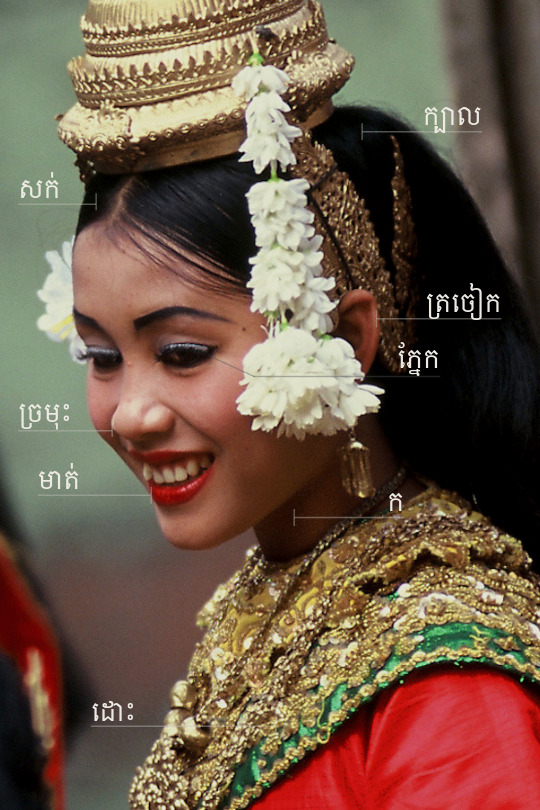#[ɗɑh]
Text
19 août 22 | trancher à ras, 2 | 39
19 août 22 | trancher à ras, 2 | 39
661
Racler, trancher : agir sur le monde. Expériences qui répondent au « comment connaîtr’ ? » du poème « connaîtr’ » de Cri & co, lu par l’auteur :
662
La question du savoir ne se limite pas à l’exploration des surfaces par raclement ; il est question dans Dâh de trancher pour faire l’expérience de la profondeur, symbolique et imaginaire, mais aussi physiologique par le véhicule du corps.…

View On WordPress
#baiser-fleur#Bataille#boxe khmère#comment connaîtr&039; ?#Cri & co#grotte#Kbach#la question du savoir#lord#Lord-lord#maxi-tête#Nietzsche#non-savoir#Padwin#rasa#suer#trancher#[ɗɑh]
0 notes
Photo


LINGUISTIC DIVERSITY CHALLENGE: southeast asia and oceania
K H M E R | ភាសាខ្មែរ
EXONYM | Khmer [kmɛər], Cambodian
ENDONYM | ភាសាខ្មែរ [pʰiə.ˈsaː kʰmae]
LOCATION | Khmer is the official language of Cambodia, but is also natively spoken in Vietnam and Thailand.
POPULATION | Approximately 13 million speakers worldwide
BACKGROUND | Khmer is an Austroasiatic language of the Mon-Khmer branch, and has incorporated influence from Sanskrit and Pali. Most Khmer dialects are mutually intelligible but have very obvious differences. Old Khmer (600-800 CE) was heavily affected by Sanskrit, and with the fall of the Khmer Empire the language became less regulated and underwent a variety of changes. Middle Khmer (14-16th centuries) exhibited dramatic lexical, morphological and phonological changes when the language started borrowing more from Thai and Lao. Modern Khmer is governed by marginally different rules than Old Khmer as a result, making it hard to understand Old Khmer without prior knowledge. It is important to be aware that there are several social registers in Khmer which extends beyond variation in pronouns. The overall vocabulary you use to talk to your sister will not be the same as what you would use when talking to royalty.
GRAMMAR | Khmer is an analytic, isolating language, which means it often uses shorter words that include less morphemes and employs the use of helper words to convey meaning instead. For example, Khmer lacks inflections, conjugations, or case endings but instead has a wealth of particles and auxiliary words to compensate. Khmer follows an SVO word-order and places modifiers after the words their modifying.
PHONOLOGY | Unlike many of its neighbors (Burmese, Thai, Lao, Vietnamese), Khmer is not a tonal language! Khmer generally places stress on the last syllable of a word, making stress non-phonemic (if you mess up your stresses, you will sound funny but you will not destroy the meaning of a word). Most words in Khmer are, on average, between one and two syllables. Most words with three or more syllables are loanwords, usually from Sanskrit or Pali. Intonation is used to distinguish mood and statements (kind of like how in English we may raise pitch at the end of a sentence to indicate a question).
SCRIPT | The Khmer script is an abugida developed from the Pallava script of India and looks visually similar to Thai and Lao. There are two groups of consonants: series one with the inherent vowel /ɑː/, and series two with the inherent vowel /ɔː/. In Khmer, these series are referred to as “voiceless” and “voiced”, as series two was intended to represent voiced phonemes from Old Khmer. This makes Khmer kinda tricky to read because voiced stops have been lost, resulting in the use of dipthongs instead. Khmer now contains two symbols for most consonant phonemes, with vowel symbols having two possible readings depending on which series the consonant they come after belongs to.
SWADESH LIST
ក្បាល [kɓaːl] | head
សក់ [sɑʔ] | hair
ភ្នែក [pʰnɛːk] | eye
ច្រមុះ [crɑ.ˈmoh] | nose
មាត់ [mŏət] | mouth
ក [kɑː] | neck
ដោះ [ɗɑh] | breast
WHY KHMER? | Khmer is another one of those languages that despite their solid status and large speaking population they end up being neglected because they’re not “Western”, nor are they valued by the global community as much as they ought to be. I already knew about Burmese, Vietnamese, Thai, and Lao, which are the other big southeast Asian languages, so this seemed like the last one to know before I consider doing the lesser-known ones (maybe in future challenges!). Khmer also has a good number of free resources for this kind of challenge so it was an easy one lol
Some of the other languages I considered also had scripts my computer wouldn’t display, which created a hassle I wasn’t ready for this time around; this obstacle is a good indication that some other languages need more recognition if major OS’s still don’t support them, so I noted those languages so I can give them special attention when I have more time to dedicate to a challenge. Part of the battle in making Langblr more diverse is finding a way to present languages that aren’t supported by half of modern devices. Just because a language has a substantial speaking population doesn’t mean it’s properly represented. Even widely spoken languages become underprivileged when they’re silenced on online platforms --Khmer just happened to be one of the luckier ones in this case.
#linguisticdiversitychallenge#linguistic-diversity-regions#khmer#cambodian#languages#langblr#linguistics#swadesh list#visual swadesh list#linguisticdiversityregions#Asian#asia#southeast asia#cambodia#vietnam#thailand#lingblr#grammar#austroasiatic
344 notes
·
View notes